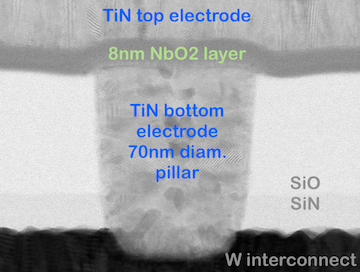Congratulations to Suhas Kumar, John Paul Strachan, and R. Stanley Williams of Hewlett Packard Labs in Palo Alto for showing not just how to make a Mott memristor, but that you can create controlled chaos with one. “We showed that this type of memristor can generate chaotic and nonchaotic signals,” says Williams, who invented the memristor based on theory by Leon Chua. An analysis of the material science and engineering of titanium sub-oxides as practiced by Williams at HPL for the production of standard memristors can be found in one of my old blog posts (http://www.betasights.net/wordpress/?p=1006).

The Figure shows a cross-section of a single Mott memristors formed by the region of the 8nm thin niobium dioxide (NbO2) layer that is between the 70nm diameter titanium-nitride (TiN) pillar functioning as bottom electrode and the blanket TiN layer functioning as top electrode.
Such a device exhibits both current-controlled and temperature-controlled (https://en.wikipedia.org/wiki/Mott_transition) negative differential resistance, and the proper choice of current and temperature can result in what I like to term “repeatable” chaos. It is repeatable in that a state can be controlably placed into or out-of chaos using non-linearities in electrical current-flow and temperature. From the abstract of the original article in Nature:
We incorporate these memristors into a relaxation oscillator and observe a tunable range of periodic and chaotic self-oscillations. We show that the nonlinear current transport coupled with thermal fluctuations at the nanoscale generates chaotic oscillations. Such memristors could be useful in certain types of neural-inspired computation by introducing a pseudo-random signal that prevents global synchronization and could also assist in finding a global minimum during a constrained search.
In a simulated circuit, an array of Mott memristors can be integrated with standard memristors to form a simulated Hopfield network (https://en.wikipedia.org/wiki/Hopfield_network). Hopfield nets seem to be some of the most apt models for human memory, so if we can just wire together a sufficient number of NbO Mott memristors with TiO standard memristors then we might be a step closer to functional AI.
Read the fine coverage at IEEE Spectrum: https://spectrum.ieee.org/nanoclast/semiconductors/devices/memristordriven-analog-compute-engine-would-use-chaos-to-compute-efficiently
Or the Nature article behind paywall: https://www.nature.com/nature/journal/v548/n7667/full/nature23307.html
—E.K.


